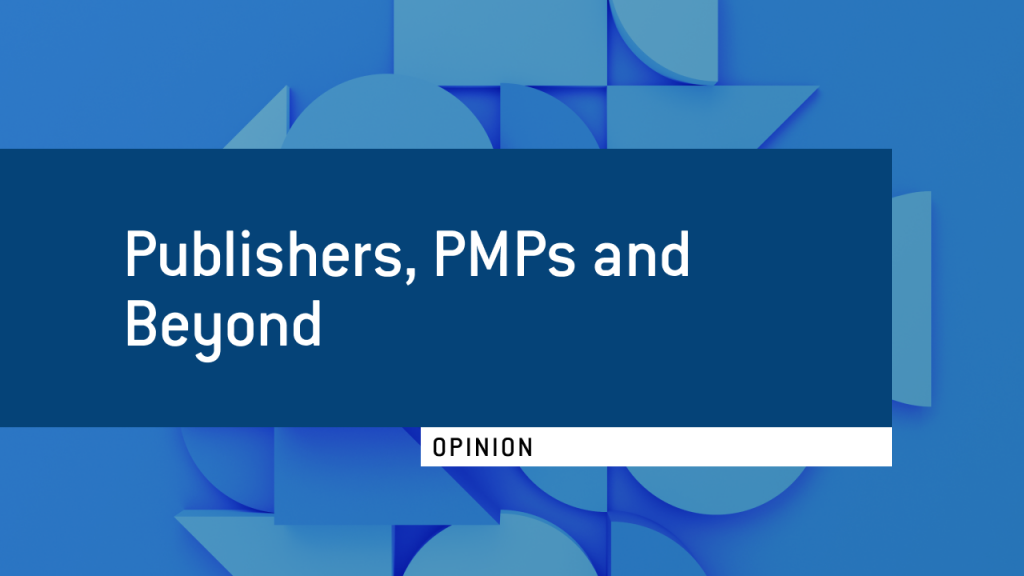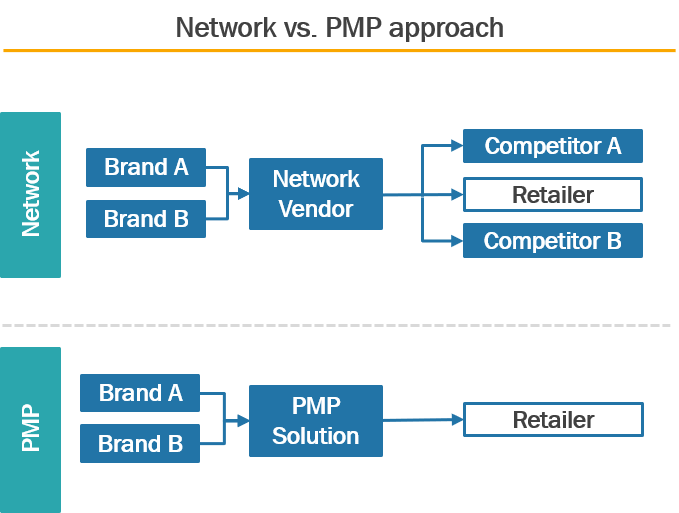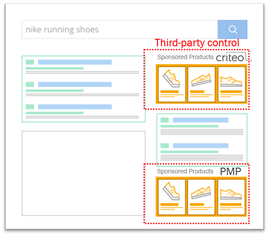For retailers choosing a site monetization strategy, the choice between ad networks and private marketplaces is more complex than it seems on first pass. Read on to discover which offers better value – and how an emerging alternative might just trump both.
Online retailers fight a permanent battle for revenue. Yet site monetization, with its ability to serve ads on one’s website, proves a tantalizing new path to growth.
With all that juicy, first-party data to play with, it feels like a much sought-after win-win! Brands enjoy increased exposure; Retailers capture more ad budget.
Scores of the latter have rushed to join the publisher’s club, giving wholesale brand marketers an opportunity alongside Amazon, Google, and Facebook for media investment.
Let’s pause on Amazon for a minute. Though lagging behind the other two in terms of revenue share, no Western rival matches it in the retail sector.
Amazon’s Advertising Solutions team can thank its Sponsored Product Ad offering for most of its staggering profits, a format we’ll focus on a lot in this article.
Sponsored Product Ads: The publisher’s secret weapon
Source: eMarketer report – 2019
Sponsored Ads weren’t always a go-to medium for advertisers. Early pioneers relied on brand-funded display ads, often purchased with co-op or market development funds.
But clunky banners suffer low CTR rates for a reason. They distract and dissatisfy, driving would-be buyers offsite and interrupting carefully crafted conversion paths.
Sponsored Ads, on the other hand, offer a seamless experience. Unlike their forebears they boast a native look and feel – crucial when integrating third-party information.
They ensure greater relevancy and, in short, offer the best value for publishers and vendors alike.
How do Sponsored Ads work?
All Sponsored Ad programs operate via programmatic auction, with every search triggering advertised products in addition to organic equivalents.
Ad placements can render on both product and category results pages.
Shoppers see them via carousel, horizontal strip, vertical sidebar, or a combination.
Adopting a Sponsored Ad program using an Ad Network
Now we’ve reminded you of what Sponsored Ads are and how they work, it’s time to assess two approaches to monetizing your site.
Many publishers look to third-party ad brokers like Criteo to conduct vendor transactions on their behalf. Partner with one of these platforms and you’ll join a large aggregate of other publishers.
Your inventory contributes to a wider realm of ad space made available to all participating vendors.
Most of the heavy lifting falls on your wholesale brand partners. They’re the ones who program campaigns using the network’s campaign management toolkit. It’s also up to them to establish campaign parameters, after which the publisher inserts all relevant tags into their pages.
For publishers seeking a non-strategic route to quick ad revenues, networks represent a straight-forward option. Decision makers can forget about finding advertisers and managing their campaigns. Instead, they can sit back and watch the revenue roll in. Sort of.
What are the main challenges with Ad Networks?
What ad networks offer in terms of convenience, they lack in several other departments. You can read a more comprehensive list elsewhere, but we’ll highlight four major ones below:
Zero transparency
Publishers and their vendor partners enter network-run auctions at a disadvantage. For a start, brands have zero visibility into which publishers they inventory from.
The illusion of control can be misleading. Brands may set their preferences – articulate their budget and audience – without knowing where their ads end up. Sure, they’d pay more to have ads appear on a well-known retailer’s site. But if their ads are just as likely to display on an obscure site, how do they bid strategically?
As a publisher, this translates as lost opportunities. In a network model, your inventory can attract a level of prestige associated with higher CPMs. By being tarred with the same brush as less valuable competitors, you lose out on premiums those ad spots may otherwise have commanded.
Lack of control
Ad networks suffer from a lack of control. In every case, they decide the delivery of ads on your website in exchange for a percentage of overall spend. You may be promised a healthy fill rate, but a high degree of variability remains.
As a publisher, you compete for that ad inventory with every other retailer offering. It doesn’t matter if you’re first, third, or tenth in line for that ad unit.
You receive no guarantees for fill rates in most categories. In fact, on average, network-reliant publishers suffer from low fill-rates in most categories: typically around the 15% mark.
Prioritizing private marketplaces
Private Marketplaces (PMPs) cast aside most network-related problems – and their popularity has grown as a result. eMarketer predicts that of the $19 billion in additional ad dollars already flooding the programmatic industry, PMPs will absorb much of that amount.
In a network model, brands spend their Sponsored Product budget using a network composed of different retailers. As a retailer, you rely on a third-party sales force, and can’t claim any exclusive budget from partners. Convincing brands to invest in retail media benefits competitors at the same time.
PMPs allow you to sell media directly to your brand partners. Brands see this partly as a media play, and partly as a way to build a strong relationship with you. Most of today’s retailers already have a PMP in place, or are considering adding one to their network approach by assigning additional ad swim lanes.
In short, a PMP delivers you more flexibility and bigger yields.
Running Sponsored Ads through PMPs tightens a publisher’s grip on proceedings. Direct deals with invite-only bidders allow you to set a fixed floor price, start and end date. They also adapt to promotional calendars.
Bypassing third-party networks escapes the high fees demanded by networks. In short, a PMP delivers you more flexibility and bigger yields.
What are the weaknesses of today’s private marketplaces?
Are some PMP solutions better than others? Actually, yes. Just like networks, most PMPs maintain control over ad placements. As a retailer, your superior product and audience knowledge matters little. Without an ability to dictate relevancy scoring, you can’t influence the outcome of which ads show where.
Relying on PMPs as the sole catalyst for Sponsored Ads protects one-on-one vendor relationships. But does it maximize revenue potential? Unless you’re blessed with infinite resources and a healthy list of suppliers, true scale can prove fiendishly difficult.
Many publishers now combine both options, running PMPs and network auctions to populate ad placements simultaneously. This dual approach makes for extra revenue opportunities. However, it also triggers new problems.
Every ad network a publisher works with requires its own dedicated ad placement; and these groups of individual ad units render via their own blocks or “swim lanes” on a retailer’s website. Things become expensive, inconvenient…and incoherent.
Not only do publishers end up shelling out for multiple ad placements; they must accept that each swim lane stays locked into service with a single demand source.
In this instance, the trade-off – more revenue potential for worse user experience – proves damaging. A page cluttered with non-harmonized swim lanes delivers duplicate content. Shoppers don’t care who serves the ads. They only care that their experience doesn’t suck.
Why a mediated approach represents the best choice for publishers
The headache caused by running separate swim lanes has led to a new paradigm in Sponsored Ad programs: consolidating different ads into a single stream.
As a publisher, blending PMPs and network ads into unified ad placements streamlines proceedings without screwing up user experience.
In recent times, a waterfall model represented the best way of doing this. Apply the right rules and you could easily preference PMPs – and lean on network-driven ads only when those from the former are unavailable.
But even this fails to ensure the best possible outcome. Though PMPs provide better overall value, network-driven ads can still generate bigger CPCs in some instances. Waterfall mediation fails to account for this scenario – leaving money on the table for publishers, yet again.
Sponsored Product Ads 2.0 with Crealytics
Most publishers share the same sentiment: today’s monetization programs just don’t cut it. Even the most sensible option – a PMP – brings its own headaches. Ad relevancy (or lack of it) remains problematic. Scaling your program beyond just a few key vendors costs money and resources. And to add insult to injury, your inventory’s potential stays trapped within certain sections of your inventory.
The current option for mediation feels imperfect. Using ad networks to backfill demand does a job, but not an ideal one. Waterfall systems’ if-then approach lack sorely needed flexibility.
At Crealytics, we surveyed hundreds of retailers to discover how best we could help them reach the next level. It resulted in an SPA program that empowers them through greater control, transparency and choice. We’ll drill deeper into how via a separate post, but you can check out three key advantages of our alternative below.
Next-level mediation
Crealytics’ mediation layer sidesteps any technical headaches. We’ve designed it to make things easy as possible for publishers who can now rely on just one, single integration. As a result, you can work with multiple demand sources and ad networks simultaneously. It’s a unified auction, without the complexity. We’ve also streamlined reporting: the system consolidates all reports into a singular set of meaningful insights, both at product and brand level.
Better ad relevancy…and higher revenue per page
Remember the old waterfall style mediation system? We’ve introduced customized factors to ensure you get highly targeted ads – and higher revenue per page. As a publisher, you get a more usable ad inventory, with an entirely biddable grid (not just the first four spots). You also score the relevancy of your organic products – and can decide whether or not you want to show ads, and determine their order when you do.
Human-led scalability
Chasing incremental media budgets from vendors soaks up time, money and effort. We get you more brands on board by supplying you with a dedicated media sales team. We also provide Ad Ops teams to help get you up and running from a technical perspective.
For more details around Crealytics’ retail media offering, as well as more information about running a more effective Sponsored Ads program, get in touch via hello@crealytics.com.







